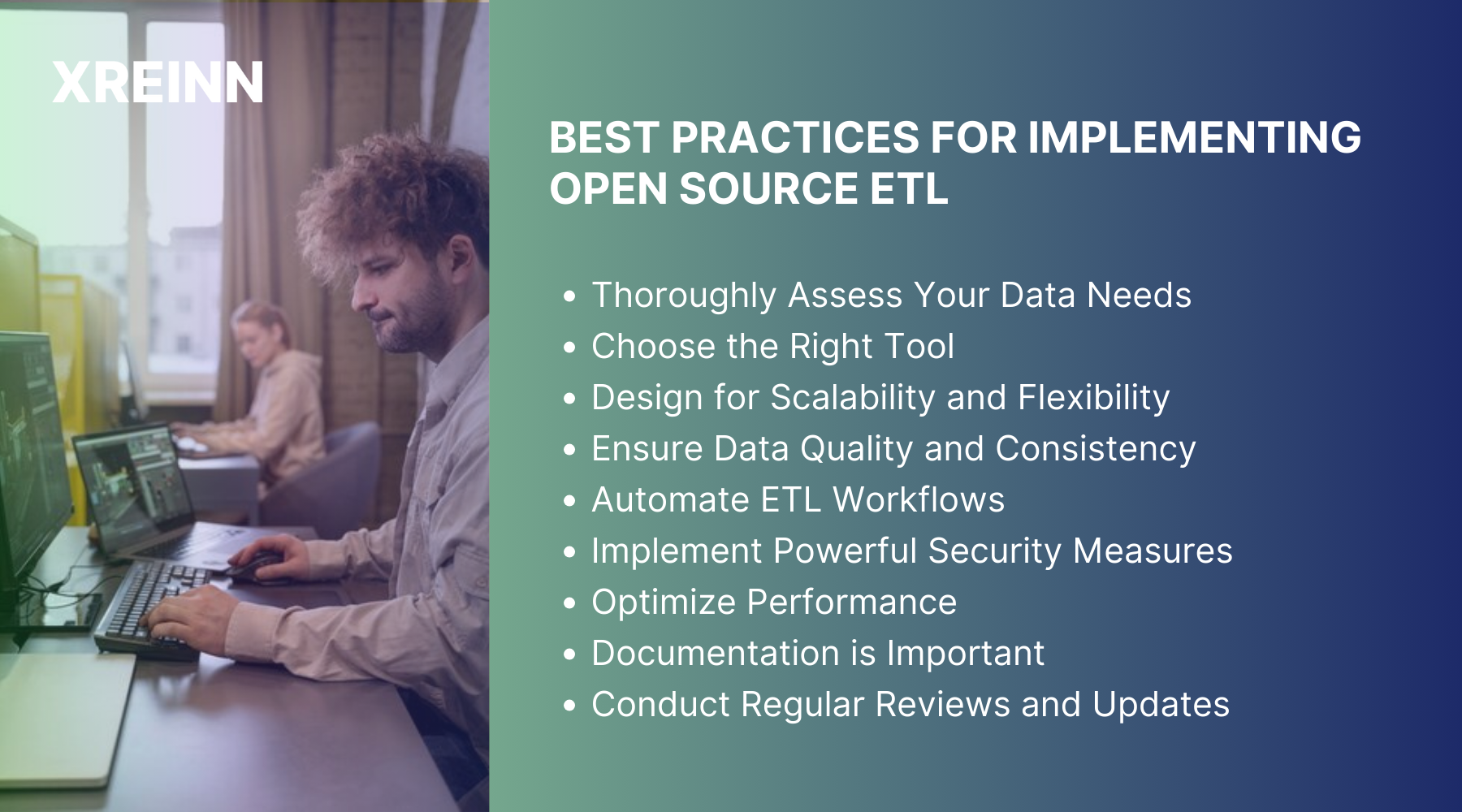Data Integration
9 Best Practices for Effective Open-Source ETL Implementation
Jul 01, 2024
ETL (Extract, Transform, Load) is a fundamental process for handling data, involving the extraction of information from various sources, its transformation to fit specific needs, and loading it into a target system. Effectively using open-source ETL tools can greatly improve your data management and analytics. To make sure your ETL processes are both efficient and scalable, careful planning and execution are important. Following best practices will help you manage large datasets, integrate different sources, and improve overall performance.
This guide highlights 9 essential practices to refine your ETL processes, ensuring you get the most out of your tools and keep a step ahead of your competitors.
Best Practices for Implementing Open Source ETL

1. Thoroughly Assess Your Data Needs
Understanding your data needs is the foundation of successful ETL implementation. Begin with a detailed assessment of your data sources, transformation requirements, and target destinations.
How to Do It?
Start by listing all your data sources, such as databases, APIs, and flat files. Identify the types and volumes of data to ensure your ETL tool can manage different data formats and large datasets. Next, outline the data transformations you'll need, from simple cleaning to more complex aggregations and joins. Document each transformation step to understand its complexity and check that your ETL tool can handle them.
Finally, decide where the transformed data will be stored—whether in a data warehouse, data lake, or another storage solution. Make sure your ETL tool integrates well with your target systems and supports the required data formats for smooth data flow.
2. Choose the Right Tool
Selecting an appropriate ETL tool is more significant for achieving your data integration goals. Evaluate tools based on scalability, community support, integration capabilities, and performance benchmarks.
How to Do It?
When selecting an ETL tool, prefer scalability to ensure it can grow with your data needs. Look for features that support both horizontal and vertical scaling, allowing the tool to handle increasing data volumes and complexities over time. Additionally, choose tools backed by active communities and strong support options. An engaged community offers regular updates, shared knowledge, and quicker issue resolution, which are invaluable for maintaining and optimizing your ETL processes.
Integration capabilities are also important. Verify that the ETL tool can seamlessly integrate with your existing systems, supporting a wide range of connectors and data sources. This ensures smooth data flow between different systems and reduces integration overhead. Finally, review performance benchmarks and real-world case studies to understand how the tool performs under various conditions. Select tools that have proven efficiency in handling large datasets and complex transformations, ensuring they meet your performance requirements.
3. Design for Scalability and Flexibility
Designing your ETL processes for scalability and flexibility ensures they can grow and adapt to changing business requirements.
How to Do It?
When implementing ETL processes, start by breaking them down into modular components that can be reused and scaled independently. This approach simplifies maintenance and updates, allowing you to improve specific parts of the process without disrupting the entire workflow. Next, implement parallel processing to efficiently handle large data volumes.
Choose ETL tools that support parallel execution to maximize throughput and minimize processing time. Finally, design flexible ETL pipelines that can easily adapt to new data sources and transformation requirements. Use configuration files and environment variables to make your pipelines more adaptable to changes, ensuring they remain powerful and flexible
4. Ensure Data Quality and Consistency
Maintaining high data quality and consistency is essential for reliable analytics and decision-making. Implement powerful validation and cleansing mechanisms throughout your ETL processes.
How to Do It?
Incorporating rigorous data validation checks at each stage of the ETL process is essential for ensuring accuracy and consistency. You should validate data types, formats, and integrity constraints to maintain high data quality. Additionally, design strong error handling mechanisms to effectively manage and log errors. Implement retry logic and alerting systems to promptly address issues and minimize data loss.
Furthermore, use data profiling tools to understand the quality and characteristics of your data. Regular profiling helps identify and rectify data quality issues early, ensuring that your data remains clean and reliable for analysis.
5. Automate ETL Workflows
Automation is key to ensuring your ETL processes run smoothly and efficiently without constant manual intervention. It also improves reliability and reduces the risk of human error.
How to Do It?
To automate the execution of ETL jobs, use scheduling tools to run these jobs at defined intervals. Tools like Apache Airflow or cron jobs are excellent for managing job timings, ensuring that processes run as needed without manual initiation. Additionally, implement monitoring and alerting systems to track ETL job performance and identify failures.
Tools like Prometheus and Grafana are ideal for real-time monitoring and alerting, allowing you to detect and address issues promptly. To manage complex ETL pipelines, employ workflow orchestration tools such as Apache Airflow. These tools provide comprehensive features for task scheduling, dependency management, and error handling, effectively streamlining your ETL processes.
6. Implement powerful Security Measures
Data security is a critical factor, especially when handling sensitive or personally identifiable information. Ensure your ETL processes comply with relevant security standards and regulations.
How to Do It?
To ensure the security of your ETL processes, start by encrypting data both in transit and at rest. Use SSL/TLS to protect data during transmission and disk encryption to secure data when stored. This dual-layered encryption approach keeps your data safe from unauthorized access throughout the ETL process.
Next, implement role-based access controls (RBAC) to restrict access to ETL processes and sensitive data. Clearly define user roles and permissions to ensure that only authorized personnel can access and modify this data. Additionally, maintain detailed audit logs to track access and modifications. These logs are essential for compliance and can help quickly identify and address any security breaches, ensuring your data remains protected at all times.
7. Optimize Performance
Optimizing the performance of your ETL processes ensures data is processed quickly and efficiently, minimizing latency and maximizing throughput.
How to Do It?
To ensure your ETL processes run smoothly, start with effective resource management. Allocate sufficient resources to each ETL job to prevent bottlenecks. Regularly monitor resource usage and adjust allocations as needed to maintain optimal performance. Performance tuning is equally important. Continuously monitor ETL processes, identifying and addressing performance bottlenecks. Focus on optimizing query performance, data transformations, and load operations to ensure efficient processing.
Additionally, implement load balancing techniques to distribute workloads evenly across resources. This approach helps maintain high availability and performance, even under heavy loads, ensuring your ETL system remains powerful and efficient.
8. Documentation is Important
Comprehensive documentation is essential for maintaining and troubleshooting ETL processes. It also facilitates knowledge sharing and ensures consistency across the team.
How to Do It?
To maintain clarity and efficiency in your ETL processes, start by thoroughly documenting each step. This includes detailing data sources, transformations, and target destinations. Use diagrams and flowcharts to visualize these processes, which makes them easier to understand and maintain. Additionally, keep comprehensive records of all configurations and settings used in your ETL tools.
This should include versioning information and change history to track modifications and ensure consistency. Implement a strong change management process to oversee any modifications to ETL processes and configurations. Utilize version control systems like Git to manage changes, ensuring everything is traceable and consistent throughout your data workflows.
9. Conduct Regular Reviews and Updates
Regularly reviewing and updating your ETL processes ensures they remain efficient and aligned with business needs. This proactive approach helps identify and address issues before they impact operations.
How to do it?
To ensure your ETL processes remain efficient and aligned with your business goals, start by conducting regular audits. These audits should review performance metrics, error logs, and user feedback to identify areas for improvement. This ongoing assessment helps optimize processes and align them with your business objectives. Additionally, stay informed about updates and new features in your ETL tools.
Incorporating these updates can influence new capabilities and improve performance. Establish feedback loops with stakeholders to ensure ETL processes meet their requirements. Regularly solicit feedback and make necessary adjustments based on user input, ensuring your processes remain relevant and effective.
Conclusion
Implementing open-source ETL tools requires a strategic approach that encompasses careful planning, powerful design, and continuous optimization. By following these best practices, you can ensure your ETL processes are efficient, scalable, and secure. This not only improves your data management capabilities but also drives better business outcomes through reliable and timely data insights.
Remember, the key to successful ETL implementation lies in understanding your data needs, choosing the right tools, and continuously refining your processes to adapt to evolving requirements

Data Analytics
Jun 27, 2024Master key concepts in data analytics with practical tips to enhance decision-making and achieve success in your projects and professional growth

Data Analytics
Jul 01, 2024Learn the essential stages of the data analytics workflow to turn your data into valuable business insights and drive growth.

